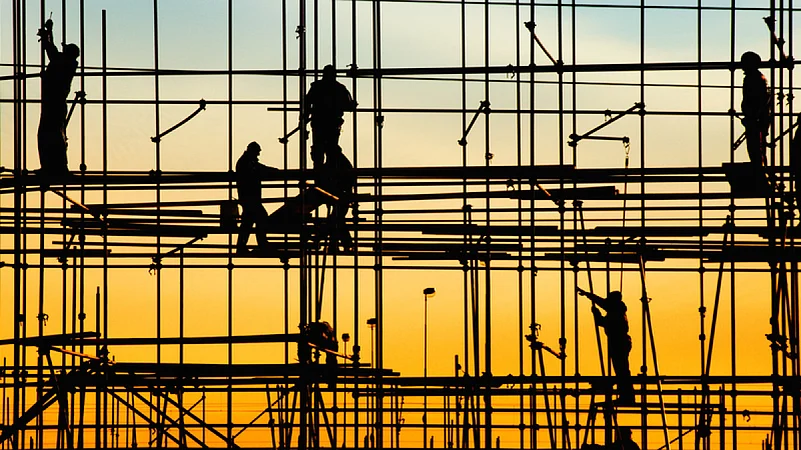Infrastructure is often the plot around which a country scripts the story of its economic rise.
And that is why infrastructure is key to India’s ambitions of becoming a developed nation. In this interview with Outlook Business, Kumar V Pratap, a former joint secretary at the Union Ministry of Finance and co-author of the book Infrastructure Financing in India, describes the challenges in India’s infra financing landscape and why the private sector is not playing a bigger role.
At the Ministry of Finance, Kumar used to look after infrastructure policy and finance. He also served as the principal economic advisor at the Department for Promotion of Industry and Internal Trade (DPIIT) until last year.
Advertisement
Why do social infrastructure projects, such as those in health, education, water supply and solid waste management, miss out on private capital? Is there a way to make these projects more attractive?
Social infrastructure projects are smaller. Cost recovery is low. Further, they are subjected to political economy issues that add to their risk profile. The private sector often finds social infrastructure projects more challenging as financial rewards are smaller and operational demands more complex.
To attract private capital in these sectors, the Union Ministry of Finance, in the 2021–22 budget, raised the viability gap funding (VGF) for water and solid waste [infrastructure projects] to 30 per cent and for health to 40 per cent and for education to 25 per cent for the first five years.
What this increased VGF does is it reduces the project cost and makes it possible to have financially sustainable operations in these under-priced sectors.
But there is no major uptake in public private partnerships (PPPs) because the government has not been able to prepare model concession agreements (MCAs) acceptable to all sectors. MCAs define the risk and rewards for the private sector and it is an international best practice to follow.
Advertisement
In your book, you suggest volumetric pricing for better user charges for public infrastructure. How can that help?
Utilities should gradually move from flat rate to volumetric pricing. In the water sector, generally, there are no water meters. You pay according to the location of the residence or office. So, there is a flat rate depending on the location instead of costs depending on consumption.
The prerequisite for volumetric pricing in the water sector would be to have water meters and gradually the rates may be increased to cover at least the operational and maintenance expenses of these assets. Volumetric water charges would make households conserve water and promote environmental sustainability.
Part of the reason for declining groundwater levels in India is that there is no charge for groundwater extraction and power supply is subsidised.
Volumetric pricing will also result in better targeting of subsidies. Volumetric pricing with increasing block tariffs would mean the beneficiaries of subsidies are the real poor and not those who consume high amounts of water.
But for volumetric pricing to succeed, it must be accompanied by perceptible service delivery improvements to make the hike palatable to users. Improvement in service coverage made possible through volumetric pricing and increased revenues for water utilities would help build political support for these changes.
Why have urban local bodies struggled to strengthen their finances?
Urban Local Bodies (ULBs) are overly dependent on grants from central and state governments. Their own sources of revenue are quite low such as flat rate property taxes. This dependence on central grants and low resources lead to poor ownership and accountability.
In the United States, infrastructure financing is carried out by municipal bonds which are used to finance more than 75 per cent of the US public sector infrastructure. But the Indian municipal bond market is quite underdeveloped and only about one per cent of urban body financial demands are met through municipal bonds.
The Ahmedabad Municipal Corporation was the first to make a bond offering in 1998. Since 1998, local bodies in other cities like Nashik, Nagpur, Ludhiana and Madurai have issued municipal bonds without state guarantees. However, low credit worthiness of ULBs as a result of weak state finances continue to impede the growth of this market in India.
In contrast, in the US we see New York City Municipal Finance Authority’s water and sewer revenue bonds are rated AA+. There is a need to develop the municipal bond market and improve ULB financing for them to play a major role in the Indian infrastructure landscape.
Advertisement
With metro projects popping up across Indian cities, can you list some lessons we can pick up from Hong Kong Metro Rail to enable ‘value capture finance’?
With large, capital-intensive public projects like metro rail, there is an increase in property prices alongside metro projects. Part of this unearned increase in private property prices can be transferred to metro projects to improve their finances. This is the spirit behind value capture finance (VCF) which is aimed at internalising externalities generated by large infrastructure projects.
More generally, VCF is based on the principle that private land and buildings benefit from public investments in infrastructure and policy decisions. These benefits are externalities generated from public investment and hence should not be included in user charges.
Therefore, there is a need to deploy appropriate VCF tools to capture a part of the unearned increment in land and buildings value. These can be used to fund projects being set up for the public by central/state governments and urban local bodies. This generates a virtuous cycle for project investment.
In Hong Kong, the government owns the land whose value is very high due to limited space. To develop the Mass Transit Rail (MTR) system, the government entered into an agreement with MTR Corporation which has 70 per cent government shareholding.
The government then transfers the land and development rights to MTR Corporation at a pre-rail price. MTR Corporation, in turn, transfers the developmental rights to private developers at an after-rail price.
After metro rail development, the land value adjacent to the metro rail skyrockets and the profit margin from this VCF mechanism is sufficient to meet the development requirements of MTR. Additionally, the developer returns the land with premium value as lease charge to the government as well as a shared part of profit with MTR Corporation, making MTR highly profitable.
The financials of Indian metro rails are primarily dependent on fare revenue and that is why all of them make operational losses. Unless non-fare revenue through shops at metro stations, advertisement revenue and more importantly property taxes are developed, we may end up replicating the outcomes of the power sector in the metro rail sector.
Individual metro rails should be given land rights along metro rail lines to supplement their fare revenues. Transit-oriented development should also be promoted by allowing high floor area ratio (FAR) for properties along metro lines. Finally, metro fares should be increased sufficiently to cover operational expenses at least.
Advertisement
What are your views on RBI’s recent draft guidelines on infrastructure financing?
The RBI has proposed to tighten project financing and commercial real estate financing norms which requires lenders to set aside higher capital for loans to infrastructure and real estate projects. Usually, land acquisition, environmental and forest clearances are major risk factors at the construction stage. So, when the projects move to the operational stage, these risks come down.
The RBI thought, and the government also thinks, this is the opportune time to bring some discipline into infrastructure lending. It is hoped this would be good for the long term because it would compel more due diligence thereby increasing the lender’s skin in the game, better project preparation and monitoring and less construction risk. The alternative to tighter norms is underpricing credit risk and a sudden increase in provisioning due to bad loans that we saw in the last decade.
To sum up, the new potential norms may be necessary for insurance against future shocks and for maintaining a healthy banking system. There would be short-term pain for infrastructure financiers and companies in terms of higher lending rates and profitability. There would be a possible impact on bank credit and infrastructure growth. But this measure promotes long term resilience and incidence of non-performing assets (NPAs) could come down further.














